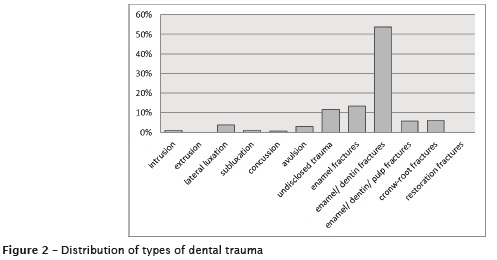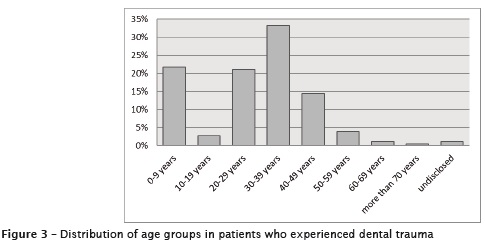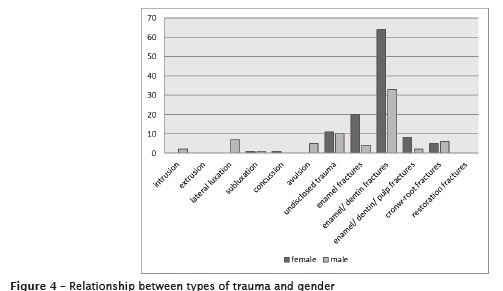Serviços Personalizados
Artigo
Links relacionados
Compartilhar
RSBO (Online)
versão On-line ISSN 1984-5685
RSBO (Online) vol.12 no.4 Joinville Out./Dez. 2015
ORIGINAL RESEARCH ARTICLE
Epidemiological data and relevance of care provided in dental emergency service of a private hospital
Luciana Stadler DemenechI; Bruno Marques da SilvaI; Kauhanna Vianna de OliveiraI; Beatriz Serrato CoelhoI; Denise Piotto LeonardiI; Flares Baratto-FilhoI; Flávia Sens Fagundes TomazinhoI
I Department of Dentistry, Positivo University – Curitiba – PR – Brazil
ABSTRACT
Introduction and Objective: The aims of this study were to determine the etiology and prevalence of dental emergency visits in a private hospital in the period from July 2009 to July 2011 and the importance of this type of service in private hospitals. Material and methods: During the study period, we analyzed 795 charts from patients seeking emergency services. The emergencies were classified as trauma, odontalgia, prosthesis, periodontal diseases, and traumatic factors. Results: Women and men accounted for 61% and 39% of cases, respectively, and the most prevalent age group was individuals aged 20 to 49 years. The predominant types of dental emergencies observed were odontalgia (52.58%) and dental trauma (22.64%). Pulpitis was the most common pathology (67% of cases) and the most frequent type of trauma was enamel and dentin fracture (54% of cases). Conclusion: A high demand for dental emergency care exists in hospital settings. Most people seek emergency dental services for emergencies related to lack of prevention and dental traumas.
Keywords: emergency treatment; toothache; oral health.
Introduction
Dental emergency services comprise the care of patients with oral problems such as dental trauma, which includes avulsion and coronary fractures with or without exposure of the pulp tissue, odontalgia, e.g., acute abscesses and other problems such as impairment of the upper airways, oral mucosa lacerations, infections, and bleeding 1,8-14. The most common procedures performed in this type of health service are related to dental caries and their sequels. Arbab-Chirani et al. 3 determined that the most common causes of hospital treatment are, in descending order, infectious diseases, dental trauma, and inflammatory processes. Thus, the main emergency interventions are related to the clinical specialty of endodontics, conservative dentistry, and multidisciplinary treatments in the case of dental trauma.
Dental trauma is still considered a public health problem worldwide because of its high prevalence and impact. The increase in violence, traffic accidents, and sports practice directly contribute to the high number of emergencies, especially in a hospital environment 2,7-13.
Although dentistry has increasingly progressed in the prevention of oral diseases, dental problems are still a reality in certain sectors of the population in Brazil and worldwide. Factors such as lack of information, low income, and neglect of oral health are commonly encountered obstacles, causing a large part of the population to seek dental care only when pain is present and the patient requires immediate resolution to his/her problem 17.
Localized health problems such as inflammation of the pulp or infection of the periapical tissues can trigger diseases such as Ludwig's Angina if left untreated, consequently leading to hospital admission. Thus, it is essential to expand resources and to establish dental emergency units in hospital settings 15. The access to emergency dental services in a hospital or in dental emergency specialized clinics reduces the use of medical services. In these cases, dental problems are treated with greater resolution because trained and qualified professionals perform the medical care practices 16.
Thus, the aim of this study was to evaluate emergency dental consultations at Vitória Hospital – Curitiba/PR from July 2009 and July 2011 to determine their prevalence and etiologies and the importance of this type of service within the hospital.
Methods
This study was approved by the ethics committee of Positivo University, Curitiba/Paraná, protocol number 154/2011.
For this study, we analyzed 795 records of emergency dental services of the Vitória Hospital - Curitiba/PR for patients who sought care between July 2009 and July 2011.
Patients are screened and referred to medical or dental specialties in the emergency department of the studied hospital. Pain or compromised teeth and/or lips are referred directly to the emergency dental service. Cases involving the face or limbs are referred to the medical emergencies service, even if the teeth are compromised. For this study, we investigated only the records of the emergency dental service.
The charts were analyzed by single professional and the following data were tabulated: gender, age, and type of emergency. The emergencies were classified according to the internal protocol of the hospital as follows: trauma, odontalgia, dental prosthesis, periodontal diseases, and traumatic factors.
Emergencies characterized as trauma were subdivided into avulsion, intrusion, extrusion, lateral luxation, subluxation, concussion, dental fractures, and undisclosed trauma. Dental fractures were subdivided into dental enamel fracture, enamel and dentin fractures, enamel dentin and pulp fractures, crown-root fracture, and restoration fracture. The classification of odontalgia encompassed pulpitis and abscesses of endodontic origin.
The classification of dental prosthesis involved cementing, relining or preparation of temporary crowns, dental bonding, or structures for removable dentures.
Periodontal diseases included pain of a periodontal origin such as gingivitis, periodontitis, excessive mobility or extensive destruction, furcation defect, sub-gingival caries, and pericoronitis. The classification of traumatic factors included the presence of foreign bodies and orthodontic braces, for example, removal of sutures, metal, wood, plastic, toothpicks, and orthodontic wires. Moreover, emergency treatments of lesions such as ulcers, blisters, spots or plaques, burns, and cuts in the lips and/or mucous membranes were also considered.
After reviewing the medical records, we performed a descriptive statistical analysis based on real numbers and percentages. The data were tabulated and the frequencies were calculated using Excel 2007 (Microsoft®).
Results
Women sought emergency services more often than men did (61% and 39%, respectively). The majority of patients were aged between 20 and 49 years (figure 1).

The most frequently observed type of emergency was odontalgia (53% of visits), followed by dental trauma and periodontal diseases (23% and 14% of the cases, respectively) (table I). Regarding the emergencies classified as odontalgia, 67% were pulpitis and 33% were abscesses.

Prostheses and traumatic factors were also observed, but at a lower percentage of the cases (7% and 4%, respectively). Among the types of trauma, the most common was fracture of enamel and dentin (54% of cases); followed by fractures of only the enamel and undisclosed trauma (13% and 12%, respectively) (figure 2). The evaluation of the age group of the patients diagnosed with dental trauma revealed that 33% of cases were aged between 30 and 39 years, followed by the age groups 0-9 years (22%) and 20-29 years (21%) (figure 3). Regarding the association between the type of trauma and gender, the data showed that women represented 67% of cases with fracture of the enamel and dentin, while men represented only 33% of these cases (figure 4).



Discussion
Projects and campaigns related to the prevention of oral diseases are currently being developed in Brazil and worldwide. Information and easy access to quality dental services are available. Although these services are free in some countries, part of the population still seeks care only when a problem is already present and/or at an advanced stage.
This reality was observed in the present study because the most prevalent type of emergency was odontalgia, which is related to primary oral problems such as dental caries and its consequences. A study by Arbab-Chirani et al. 3 showed that pain due to infectious processes such as caries was the predominant reason people sought emergency care.
In this study, the prevalence of pain-related emergencies caused by infectious processes was followed by dental trauma. Similarly, the study by Sakai et al. 17 showed that dental trauma was the second most common reason for seeking emergency dental care at the hospital level.
A study similar to ours assessed different types of dental emergencies in hospitals and noted that dental trauma was the most common reason for seeking dental emergency services, followed by dental infection, oral bleeding, temporomandibular disorders, prosthesis failure, and problems with dentures and orthodontic braces 5.
The prevalence of dental trauma may have been more significant than this study suggests because the professionals who provide emergency care lack knowledge regarding differential diagnoses of types of dental trauma. This was evidenced by the large number of records that did not provide detailed information and classified these cases as undisclosed trauma.
With respect to dental trauma, another fact that must be analyzed is the conduct and hospital protocol of the institution under evaluation. Trivedy et al. 20 stated that dentistry is a relatively new service in the hospital environment compared to medical care, thus making the relationship between doctors and dentists difficult. This fact was confirmed in the institution examined in this study because patients who had injuries or abrasions to areas of the body such as the skin, lips, or arms and legs were primarily directed to medical care and only received dental care subsequently. Since most cases of dental trauma also include some type of external injury, consultation is restricted to the medical sector only. Thus, teeth compromised by trauma may often go undiagnosed and the patient is not referred for appropriate treatment and preservation.
According to Quiñonez et al. 16, access to specific dental service reduces the use of hospital services for dental problems. Furthermore, physicians do not always have the specific knowledge to correctly diagnose and treat dentofacial emergencies 20.
Austin et al. 4,6 reported that the high demand for emergency dental care in a hospital is due to the reduced schedules of dental offices. Moreover, informal information networks such as friends and family are an important source of information for seeking dental care in hospitals.
Patients often seek care in a hospital setting only for immediate resolution, and they do not continue the treatment or monitor the dental problem. This is confirmed by the large number of patients who seek care for a problem that was treated previously. Thus, some patients were seen and referred for further treatment, but returned with the same problem due to the large number of dressing changes required for endodontic cases of pulpitis and abscesses. However, only the first visit was considered for this study.
When evaluating the age of the pat ients who sought emergency care services, we noted a prevalence of young adults aged 20-29 years. In these cases, the most common types of emergency were caries and pulp infections. The prevalence of this age group with these types of emergencies is presumably due to the lack of basic knowledge of oral health in young adults. In contrast, when compared with studies in which dental trauma is the prevalent diagnosis, the mean age of the cases is lower than 18 years 7,12-9.
In this study, an evaluation of the relationship between trauma and age revealed that the highest prevalence was in the 30–39-year age group (33%), followed by children aged 0-9 years (22%). The large number of children and adolescents who practice sports or some other type of school activity or the lack of coordination and dexterity at a younger age may explain the high prevalence among children. Violence and accidents were the main factors involved in the 30-39-year age group 13,12-18.
Cases of dental trauma, which were classified as fracture of enamel and dentin, were prevalent in women with an average age of 30 years. This result differs from most studies that assess trauma, which report that this type of dental trauma is most frequent in male school-age children 13,12-18.
Results similar to those observed in this study can be found in studies in which the cause of dental trauma is domestic violence 11-21. Garbin et al. 10 and Stevenson et al. 19 reported that fracture is the most prevalent type of trauma in women 30-40 years of age (59% of cases), and physical aggression is the main cause. The latter study was conducted over a period of 3 years and showed that women between 20 and 39 years of age comprised 90% of the victims of domestic violence and robbery. The main factors associated with this reality are female physical frailty and alcohol consumption by the women's partners. Although we did not find a correlation between the data of this study and domestic violence, it is estimated that 2.5 million women are victims of physical aggression worldwide 10,21. According to Gerber et al. 11 domestic and interpersonal violence, such as robberies, are still poorly studied topics. However, women are clearly the most common victims and dental trauma is associated with violence. The dentist is often the first to evaluate the victims, and thus has the obligation to recognize the signs and indications of violence. Women may omit the real cause of the trauma because the abuser is the woman's partner in most cases, hindering or preventing a record of the cause of trauma 21.
Conclusion
Based on the methodology used and the results obtained, we conclude that:
• Dental emergency consultations in hospital environments are extremely important and a demand exists for these services.
• The pain resulting from dental pulp problems and dental trauma were the most common reasons that people sought emergency dental care in a hospital setting.
• Awareness of the main causes and the prevalence of these types of emergencies are important for developing a policy of resolute hospital dental care, in which immediate relief of pain or discomfort and a correct referral provides an effective treatment.
References
1. Agostini FG, Flaitz CM, Hicks MJ. Dental emergencies in a university-base pediatric dentistry postgraduate outpatient clinic: a retrospective study. ASDC Journal of Dentistry Children. 2001;68(5-6):316-21. [ Links ]
2. Ankola AV, Hebbal M, Sharma R, Nayak SS. Traumatic dental injuries in primary school children of South India – a report from districtwide oral health survey. Dental Traumatology. 2013;29(2):134-8.
3. Arbab-Chirani R, Chevalier V, Roux M, Boisramé-Gastrin S, L'Azou D, Colemard F. On call emergency dental hospital service: creation and preliminary results. Revue d'Epidémiologie at de Santé Publique. 2010;58(3):217-24.
4. Austin A, Jones K, Wright D, Donaldson N, Gallagher JE. Use of the out-of-hours emergency dental service at two southeast London hospitals. BMC Oral Health. 2009;25:9-19.
5. Bae JH, Kim YK, Choi YH. Clinical prevalence of dental emergencies and dental trauma at a university hospital center in Korea. Dental Traumatology. 2011;27(5):374-8.
6. Bücher K, Neumann C, Hickel R, Kühnisch J. Traumatic dental injuries at a German University Clinic 2004-2008. Dental Traumatology. 2013;29(2):127-33.
7. Correa MB, Schuch HS, Collares K, Torriani DD, Hallal PC, Demarco FF. Survey on the occurrence of dental trauma and preventive strategies among Brazilian professional soccer players. Journal of Applied Oral Science. 2010;18(6):572-6.
8. Damé-Teixeira N, Alves LS, Susin C, Maltz M. Traumatic dental injury among 12-year-old South Brazilian schoolchildren: prevalence, severity, and risk indicators. Dental Traumatology. 2013;29(1):52-8.
9. Dua R, Sharma S. Prevalence, causes, and correlates of traumatic dental injuries among seven-to-twelve-year-old school children in Dera Bassi. Contemporary Clinical Dentistry. 2012;3(1):38-41.
10. Garbin CA, Guimarães e Queiroz AP, Rovida TA, Garbin AJ. Occurrence of traumatic dental injury in cases of domestic violence. Brazilian Dental Journal. 2012;23(1):72-6.
11. Gerber B, Ahmad N, Parmar S. Trends in maxillofacial injuries in women, 2000-2004. The British Journal of Oral & Maxillofacial Surgery. 2009;47(5):374-7.
12. Gong Y, Xue L, Wang N, Wu C. Emergency dental injuries presented at the Beijing Stomatological Hospi tal in China. Dental Traumatology. 2011;27(3):203-7.
13. Guedes OA, de Alencar AH, Lopes LG, Pécora JD, Estrela C. A retrospective study of traumatic dental injuries in a Brazilian dental urgency service. Brazilian Dental Journal. 2010;21(2):153-7.
14. Mani SP, Cleaton-Jones PE, Lownie JF. Demographic profile of patients who present for emergency treatment at Wits Dental School. The Journal of the Dental Association South Africa. 1997;52(2):69-72.
15. Nalliah RP, Allareddy V, Elangovan S, Karimbux N, Lee MK, Gajendrareddy P et al. Hospital emergency department visits attributed to pulpal and periapical disease in the United States in 2006. Journal of Endodontics. 2011;37(1):6-9.
16. Quiñonez C. Self-reported emergency room visits for dental problems. International Journal of Dental Hygiene. 2011;9(1):17-20.
17. Sakai VT, Magalhães AC, Pessan JP, Silva SM, Machado MA. Urgency treatment profile of 0 to 15 year-old children assisted at urgency dental service from Bauru Dental School, University of São Paulo. Journal of Applied Oral Science. 2005;13(4):340-4.
18. Soriano EP, Caldas Jr. AF, Góes PS. Risk factors related to traumatic dental injuries in Brazilian schoolchildren. Dental Traumatology. 2004;20(5):246-50.
19. Stevenson TR, Goodall EA, Moore CB. A retrospective audit of the extent and nature of domestic violence cases identified over a three year period in the two district command units of the police service of Northern Ireland. Journal of Forensic and Legal Medicine. 2008;15(7):430-6.
20. Trivedy C, Kodate N, Ross A, Al-Rawi H, Jaiganesh T, Harris T et al. The attitudes and awareness of emergency department (ED) physicians towards the management of common dentofacial emergencies. Dental Traumatology. 2012;28(2):121-6.
21. Zeitler DL. The abused female oral and maxillofacial surgery patient: treatment approaches for identification and management. Oral and Maxillofacial Surgery Clinics of North America. 2007;19(2):259-65.
 Corresponding author:
Corresponding author:
Flávia Sens Fagundes Tomazinho
Departamento de Odontologia – Universidade Positivo
Rua Prof. Pedro Viriato Parigot de Souza, 5.300 – Campo Comprido
CEP 81280-330 – Curitiba – PR – Brasil
E-mail: flavia.tomazinho@gmail.com
Received for publication: July 13, 2015
Accepted for publication: August 19, 2015













